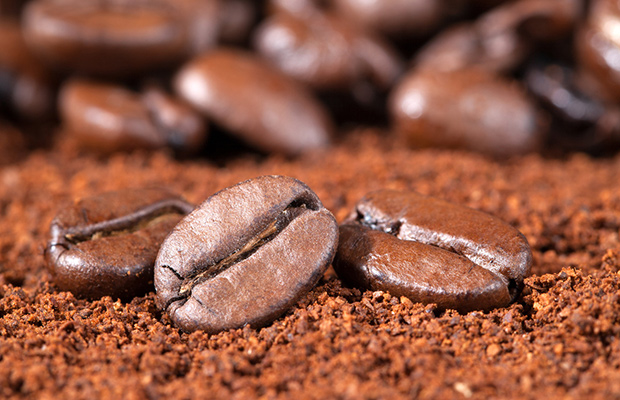
It’s the magic potion that helps more than 80 percent of us stay alert behind the wheel, keeps us from falling face first into our keyboards, and gets us through a late night at work. We’re talking about caffeine — the most widely used drug in the world.
The Science of Caffeine
Caffeine is a nervous system stimulant that can make us feel more awake, help combat fatigue and even improve focus and concentration. “When a person eats or drinks something containing caffeine, the person feels effects similar to the effects of other stimulant drugs, such as increased alertness, improved mood, increased breathing rate, and increased gastrointestinal activity,” says Maggie Sweeney, a postdoctoral research fellow at John’s Hopkins School of Medicine.
RELATED: The 7 Most Unhealthy Iced Coffee Orders
But how exactly does this helpful elixir get down to business? Let’s get nerdy for a sec.
“Consuming up to 400 mg of caffeine per day is safe for the majority of healthy adults.”
The chemical structure of caffeine is very similar to a molecule called adenosine, which is naturally present in every person’s brain. The brain is filled with receptors for these adenosine molecules. Normally, when those receptors fill up with adenosine it makes us feel tired. But because the structure of adenosine and caffeine is so similar, caffeine can fit right into those receptors as well. When caffeine locks in to the adenosine receptors, it makes us feel more alert and energetic. (See ya later, afternoon slump!)
“Caffeine may also act on other brain systems associated with the rewarding stimulant effects we know to be associated with caffeine, such as improved mood and talkativeness,” says Sweeney.
How Much Caffeine Is Too Much?
According to the Mayo Clinic, consuming up to 400 mg of caffeine per day is safe for the majority of healthy adults. That’s equivalent to anywhere from three to five eight-ounce cups of coffee, or five cans of Red Bull. (And no, factoring in sugar, we don’t exactly recommend that…) Some people are, of course, more sensitive to the effect of caffeine and may find 400 mg to cause negative side effects, and there are other circumstances that affect how much caffeine some people should consume. “Women who are pregnant are generally recommended to consume less than 200 mg per day. Children and adolescents should keep caffeine use to a minimum as well, in part because they may be more sensitive to caffeine than adults,” says Sweeney.
So what happens when you consume more than the recommended max of 400 mg? “Caffeine intoxication,” which, Sweeney says, can result in nervousness, restlessness, agitation, insomnia, racing or rambling thoughts and speech, excessive urine production and/or irregular heartbeat. Some research also shows that consuming upwards of 500 mg to 600 mg per day can contribute to insomnia, restlessness, irritability, upset stomach, fast heartbeat and even muscle tremors.
RELATED: Should You Drink Coffee Before a Workout?
It will probably come as no surprise to regular coffee (or tea, or soda, or Red Bull) drinkers that caffeine, like other drugs, can be somewhat addictive. It’s easy for regular caffeine consumers to build up a tolerance to and dependence for this easy-to-find drug. Once that reliance builds up, you may experience some less-than-pleasant symptoms, including headaches or increased drowsiness if your body doesn’t get the caffeine it craves. “The best way to avoid withdrawal symptoms is to limit caffeine consumption, possibly avoiding drinking it every day and/or consuming only a small amount per day,” says Sweeney.
Caffeine Content, Drink by Drink
So just how much caffeine is in your favorite beverage? We took a closer look at the caffeine content of some popular beverages, from coffee and tea to soda and energy drinks.

Note: Caffeine counts based on individual serving size. Content of tea can vary based on steep time. The longer it steeps, the more caffeine.
How to Curb Your Habit
Surprised by how much caffeine you might really be consuming every day? Here are some helpful tips to curb (or kick!) the habit:
1. Track your intake. Log how much you’re consuming, and take note of how it makes you feel. If you notice jitters or sweats, you’re probably consuming too much. Also pay attention to how you sleep at night — caffeine consumption can contribute to insomnia and restlessness.
RELATED: THIS Is Your Body on Sleep Deprivation
2. Cut back gradually. Go completely cold turkey and your body could show withdrawal effects such as headache or irritability. Instead, cut back one cup at a time to allow your body to get used to running on less caffeine.
3. Opt for decaf. Despite its name, decaf coffee, tea or soda is not completely free of caffeine. (An average 8-ounce cup of decaf coffee still has about 6 mg of caffeine. If you still want a small jolt (or a tasty latté), opt for a cup of decaf, or half-caf.
Think you want to kick the caffeine all together? Good news: Compared to most other drugs, caffeine is much easier to wean off of. Cut it out, and any unpleasant withdrawal symptoms should disappear within 10 days or so.
